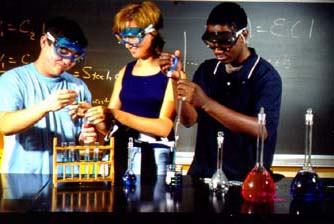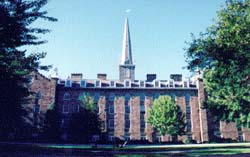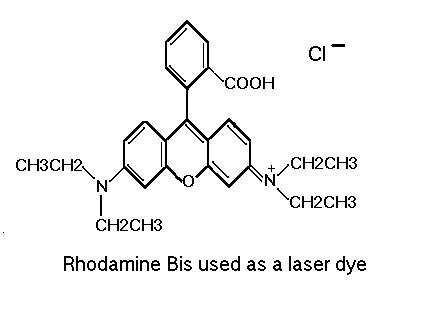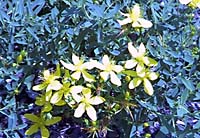The HHMI Science/Math Workshop at Kenyon College
The Howard Hughes Medical Institute (HHMI) Science/Math workshop
is designed to facilitate the transition to college life for first-generation
college students starting at Kenyon. This is accomplished by introducing
the students to the college environment and
college-level academics. At the end of this
two week summer program, students are more confident about enrolling in
college and are better prepared to meet future challenges.

|
|
Students (from left to right) Nathan Hara, Christine Yoon, and
Arthur (Lee) Towns at the bench.
|
Environment

|
|
Old Kenyon dormitory
|
Our first goal is to accustom students to college life. For two weeks
students live in the dormitories with roommates and gain experience with
the independence of living away from home. They meet future
classmates, professors and college support-staff, and navigate their
way around campus. Students attend tutorials on how to operate
the Kenyon computer system and how to effectively utilize library resources.
Their familiarity with the campus and knowledge of college support services
gives them enhanced confidence as they begin their college careers.
They also forge strong friendships that will see them through the next
four years.

|
|
The 1999 HHMI Workshop Participants
|
Back to the top
Academics
The main goal of the HHMI summer program is to acclimate students to
the rigors of college level academics, particularly in the math and sciences.
To this end, students engage in three college level laboratories,
one each in physics,
chemistry
and biology. During the two week program students
are responsible for completing daily
reading assignments
. They are also responsible for two major projects, a multimedia
presentation based on library research of a medicinal herb, and a formal
laboratory report from one of the three labs.
Laboratories
To familiarize students with working in a laboratory, students complete
labs in each of three scientific disciplines, physics, chemistry and biology.
In all three labs students utilize the skills required in their college
lab classes: the ability to follow a protocol, to accurately generate and
record data, to mathematically manipulate the data with the aid of computer
software and to interpret results. A range of techniques and principles
are employed and students hone their critical thinking skills. One lab
is chosen to write up as a formal laboratory report and includes an abstract,
background, materials and methods, results, discussion and references.
This may be the first such report a student has written. These
reports undergo many revisions with instructor feedback until they reach
the quality expected in a college science laboratory class.
In fact, many students save their reports to use as an example in
future classes. The successful completion of these labs allows the
students to enroll in their college science lab classes with enhanced confidence.
Back to the top
Physics

In the physics lab students drove a go-cart and used a computer video
system to calculate acceleration under 3 different conditions: accelerating,
decelerating and rounding a curve at a constant velocity. Students
set up a track of measured length. A video camera positioned to view
the entire track taped each go-cart run. The resulting
videos were digitized to calibrate and store data for go-cart
position as a function of time. These data were imported into
a curve fitting program and physics equations called the kinematic
equations were used to determine accelerations. The data were fit
by either a quadratic equation (for acceleration and deceleration runs)
or by a linear equation (for circular runs). The accelerations and
their uncertainties were plotted on a measurement comparison graph to visualize
the precision and agreement of the experimental values. In this lab
students were introduced to basic physics principles such as velocity and
acceleration. They became familiar with computer data acquisition
and analysis software. They fit data to both linear and quadratic
equations and generated graphs that included error bars.
Back to the top
Chemistry

In the chemistry lab, students determined the identity and concentration
of an unknown dye solution. Each pair of students obtained a different
known solid dye and prepared a series of solutions of different molarities
accurate to three significant figures. They then used a spectrophotometer
to obtain an absorption spectrum of a solution in the middle concentration
range. After determining the wavelength of maximum absorbance, the
absorbance at this wavelength was recorded for all solution concentrations.
Using Excel, a calibration plot of absorbance versus concentration was
generated. Students then received an unknown dye solution and measured
its absorption spectrum. They could identify this solution by comparing
its spectrum to those of the known dyes. The calibration plots were
used to determine the concentration of their sample. This lab introduced
students to many concepts and techniques. They learned to accuratelyweigh
solids, prepare solutions with a volumetric flask and calculate dilutions
to the correct number of significant figures.
They gained experience with scientific instrumentation (analyticalbalance
and spectrophotometer). They investigated the relationship between
concentration and absorption and were able to qualitatively and quantitatively
analyze an unknown dye solution.
Back to the top
Biology

In the biology laboratory the students actually designed their own experiments
to test factors that affect heart rate. The students were given a
brief lecture on the cardiovascular system and basic principles of cardiac
function. Students then measured their own pulses and the class results
were listed on the chalk board. There was quite a lot of variability
in the range of heart rates recorded. The students hypothesized as
to factors (i.e. fitness level, weight, gender, emotional state, posture)
that may have caused the observed variability. They then formulated
experimental protocols to test two of these factors, gender and posture.
After collecting the data, students used Excel to statistically and graphically
analyze the data. They found that men had a lower heart rate than
women and that standing subjects had an elevated heart rate compared to
supine subjects. This lab introduced students to formulating hypotheses,
the elements of proper experimental design, and the concept of statistical
significance.
Back to the top
Readings
Students and professors also meet to discuss various scientific topics
based on assigned readings. Some of these reading stretch the
limits of the students understanding, and the students learn how to formulate
questions. Due to student interest, these discussions often become
informal debates about current scientific issues affecting society such
as cloning, cosmic origins and globalwarming. Students gain an appreciation
for the fact that scientific knowledge is not static but evolves.
Additionally, they discover that scientific research can impact society
and thus is a worthwhile pursuit.
Presentations
|
Photo credit P. Heithaus
|
 |
|
St. John's wort (Hypericum perforatum)
|
The highlight of the program are multi-media presentations on one of the
medicinal plants found at the Brown Family Environmental Center at Kenyon
College. Working in groups, students engage in library research of
their chosen plant using book, journal and web-based sources. Using
Microsoft PowerPoint, they create visually stunning presentations that
they orally present to the entire group (each group member must speak during
the presentation). Not only do students learn how to find information,
for some students it was their public speaking debut. Students truly enjoyed
putting their presentations together and were justifiably proud of the
results.
Back to the top
|